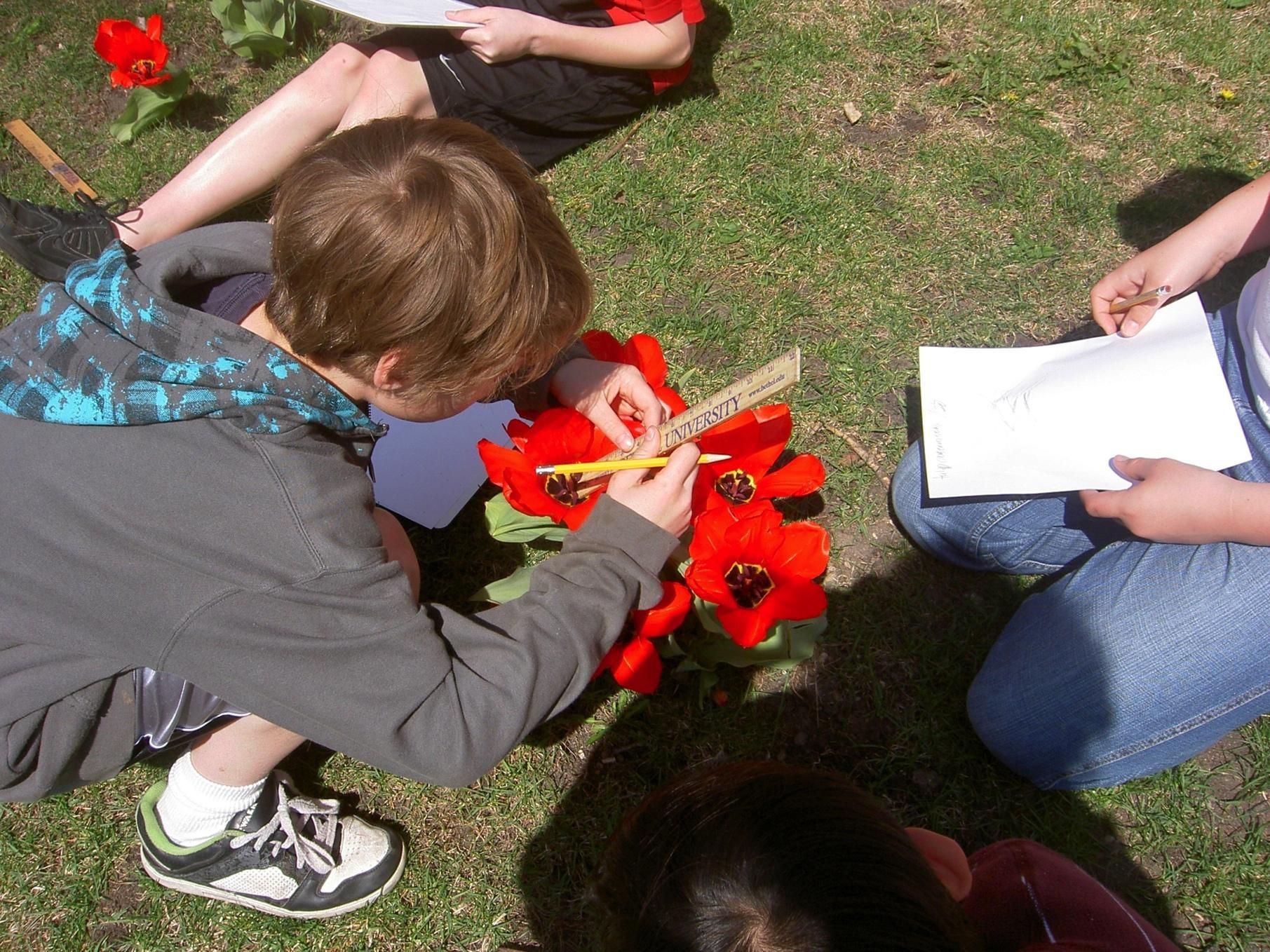Citizen science has the potential to make a difference in the lives of others. Most importantly, learners of all ages can become better observers of God’s intricate design and earth-keepers of God’s creation through this powerful partnership of volunteers and scientists known as citizen science.
Citizen science has been called crowdsourcing science, community science, amateur science, civic science, and more. Citizen science is an immersive experience that expands science knowledge and literacy using volunteers to observe, collect, and record data in collaboration with experts. According to the National Phenology Network, “Citizen science involves research, data collection, and collaboration between scientists and volunteers.”
For my students and me, citizen science ignites the power of observation, purposeful measurement, and sharing insights that shine the light on the problems we see in our part of the world. It is the perfect avenue to teach the biblical principle of creation care.
History of Citizen Science
Citizen science is not a new phenomenon. Ancient civilizations, as well as farmers, have kept detailed records of weather phenomena. In 1776, Thomas Jefferson recruited one person in each county in Virginia to record wind direction and temperature two times each day. How do we know migratory bird patterns? How do we understand the impact of pesticides on insects? Local citizens recorded and reported their findings and concerns.
In response to a declining bird population around December 1900, the Christmas Bird Count began. This annual global, community, and family tradition continues and has contributed to our understanding of climate change, birds nesting, overwintering patterns, and species’ decline. According to the World Wildlife Fund, over the past 40 years there has been 28 percent fewer vertebrates, 35 percent fewer butterflies, and 1.5 million fewer birds living on Earth.
Statistics like these motivated me to find opportunities to be part of the solution. As such, I had my students participate in projects like Cornell Lab of Ornithology’s eBird and FeederWatch. Sitting by our classroom windows with checklists, iPads, and cameras, students watched, pointed, observed, and recorded the birds they saw. With each observation, students entered their bird observations and photos to the online database. These student volunteer observations are used by scientists and government agencies to make informed decisions about conservation efforts, ecosystem protection, and human impact on migration patterns.
What Is the Value of Citizen Science?
Citizen science is the perfect complement for teaching best practices in science from a biblical perspective. It allows students to think and act like scientists. Exemplary science for the Christian teacher is much more than hands-on learning. Students are constructing science knowledge, not just consuming it. Participating in citizen science helps students discover God’s creation through questioning, investigating, analyzing, and creating claims. Students are working collaboratively to answer questions and solve real-world problems.
I was convinced that citizen science was something I needed all students to experience after I took part in a grant project that brought monarch butterflies to the classroom. We received 50 minuscule eggs on milkweed leaves. As a class, we were charged with raising these eggs to adulthood. The process that intrigued students the most was watching the monarch hang upside down in a “J” shape to make its iridescent green chrysalis. During this process that took several hours, my classroom became a beehive of activity with students crouching at eye level with the vulnerable larvae, whispering observations and words of encouragement to the monarchs. Students who had been reluctant learners became attentive protectors of each monarch from larvae, to chrysalis to adult. We learned about insect life cycle, the importance of milkweed, and the migration journey each butterfly would take. In fact, it was a teacher named Jim Gilbert and his middle school students from Minnesota who tagged a monarch that proved to scientists that their monarch butterfly migrated all the way to Mexico!
An inspiring story of the impact of citizen science involves the Butterfly Wranglers of Walla Walla, Washington. In nature, 7 out of 100 monarch eggs become an adult butterfly. However, this group of citizen scientists was able to raise and release 80 adults for every 100 eggs. Interestingly, these Butterfly Wranglers were permanent residents of the state penitentiary in Walla Walla. My students found this to be a wonderful example of how citizen science can be redemptive, reach beyond boundaries, and impact people as well as ecosystems.
Our Avail Academy school community also participates in the annual Tulip Test Garden. Using the Journey North website, my students record the emergence of tulips in our school garden. Their observations are added to a North American map. Students are able to compare our region with other regions and were able to see the archived record of the annual tulip blooming dates by region. More importantly, they saw how individual and local observations contributed to the bigger picture of understanding species distributions in the face of global change.
6 Reasons to Incorporate Citizen Science in Your Classroom
- Citizen science can be done anywhere: It can be done from your home, on a walk, at school. Citizen science can even be done from your computer or cell phone. During social distancing and stay-at-home orders, citizen science projects are a great way to reach out beyond your home and make a global difference.
- Anyone can participate: According to citizen science Zooniverse, “Anyone can be a researcher.” During distance learning, observations are often done by families. The Track a Lilac Citizen Science Project asks observers to use an app to share photos taken of the breaking leaf buds and full flowering of lilac bushes.
- Creates collaboration and connection with a global community: Citizen science connects a community of like-minded people. It recognizes that we are stronger together. Equipped with a computer or an app, observers can share and combine global observations and phenomena. Citizen science broadens our perspective of God’s world because it connects us with our neighbors as well as people across the globe.
- Participating in citizen science helps us care for God’s creation: Richard Louv, author of Last Child in the Woods, states that “We cannot protect something we do not love. We cannot love what we do not know, and we can not know what we do not see.” Citizen science provides a concrete way for students, teachers, and families to practice their call to be stewards of God’s creation. These projects provide a means for us to deepen our connection with God’s creation.
- Citizen science sharpens our observational skills: Each year I introduce my students to citizen science by teaching them about the topic of phenology. A resource that I use with students and families is the USA National Phenology Network and Natures Notebook. Phenology is an account of seasonal changes and their effect on plants and animals in a given location. Students keep a monthly record of our observed local seasonal changes. The use of phenology in a classroom setting helps students to develop observation, data collection, and journaling skills.
- Citizen science is compatible with NGSS science practices: Citizen science allows students to think and act like scientists. While participating in these global projects, students ask questions about what they are observing, analyze data collected by others, construct explanations, and learn to communicate.
Putting Citizen Science into Practice
Making citizen science a part of your classroom or at-home learning routine can greatly increase passion for science, engagement with God’s creation, and students’ love for the natural world. Here are five great resources to get you started:
- Cornell Lab of Ornithology: Volunteers share bird observations that help scientists reveal how birds are affected by habitat loss, pollution, and other environmental changes.
- National Geographic Citizen Science Projects: National Geographic sponsors regional Biobliz events that focus on counting regional species over a short period of time and provides list of natural science-based citizen science projects.
- CitizenScience.gov: This official government site provides a searchable database that contains a government-wide listing of citizen science and crowdsourcing projects designed to improve collaboration between volunteers, scientists, and local and federal agencies.
- Scistarter: This online community is dedicated to improving the citizen science experience for project managers and participants. This site contains Over 3,000 projects, resources, tools, and regional events for families and educators.
- Zooniverse: Zooniverse exists as an online global community that assists researchers. Most citizen science projects ask volunteers to go outdoors to make observations. For this site, you only need a computer. Some call this site “armchair” citizen science. Volunteers are asked to study and answer questions about authentic images of objects, galaxies, historical records, and videos of animals.
Did you know snapping photos of plants and listening for frog calls can help scientists? During our time of social distancing, connect online with likeminded citizens who are sharing observations about nature with research scientists and government agencies. Share on the CSI Facebook page what citizen projects your class is involved with. Citizen science is the perfect way to actively care for God’s creation.
Resources
Copper, Caren. Citizen Science: How Ordinary People Are Changing the Face of Discovery. New York: The Overlook Press, 2016.
Louv, Richard. Last Child in the Woods: Saving Our Children from Nature-Deficit Disorder. Chapel Hill, NC: Algonquin Books of Chapel Hill, 2008.
Trautmann, Nancy M., NancyLee R. Bergey, Terry M. Tomasek, and Jennifer Fee. Citizen Science: 15 Lessons That Bring Biology to Life, 6–12. Arlington, VA: NSTA Press, 2013.

Participating in a tulip test garden helps students see how local observations contribute to the bigger picture of the weather and climate change.

Citizen science helps learners of all ages to become better observers of God’s intricate design and earthkeepers of creation.

Developing observation, data collection, and journal writing skills, provides a means for us to deepen our connection with God’s creation.

